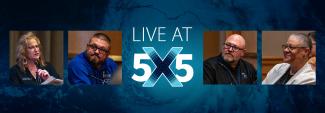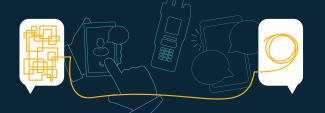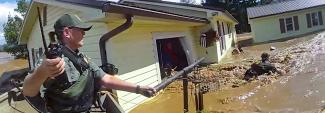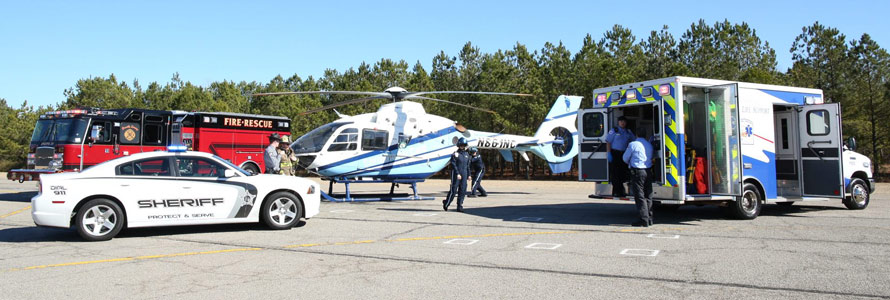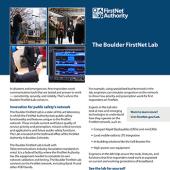Summary
Senior Public Safety Advisor Bill Schrier highlights emerging technologies that can benefit first responders and transform public safety services.
Guest
Dave Buchanan
FirstNet Authority Executive Director of Public Safety Advocacy
Bill Schrier
FirstNet Authority Senior Public Safety Advisor
Transcript
Preview
Narrator: You're listening to Public Safety First, a podcast to help you learn about the First Responder Network Authority and how you can be part of the future of public safety technology.
And now your host, Dave Buchanan.
Narrator: You're listening to Public Safety First, a podcast to help you learn about the First Responder Network Authority and how you can be part of the future of public safety technology.
And now your host, Dave Buchanan.
Dave Buchanan: Welcome to the Public Safety First podcast. I’m delighted to be here today with you in the first episode I had a chance to record here in 2019. I’m grateful for the opportunity we had to begin this podcast series last year, where we had 16 episodes where we heard from first responders from around the country about how they’re using FirstNet, how they hope to use FirstNet, and learning some best practices and use cases from those that are putting to use this new technology to improve public safety in their communities. Glad to be joined today by Bill Schrier. Bill Schrier is a member of our FirstNet Public Safety Advocacy team where he’s a senior advisor responsible for working with public safety to understand their technological and operational needs, to be able to connect their operational needs to existing technologies, and to work with industry to promote innovations to solve public safety’s operational challenges. Welcome to the podcast, Bill.
Bill Schrier: Thank you, Dave. Glad to be here.
Dave Buchanan: So Bill, I wanted to start – I know you just came back from Las Vegas from the Consumer Electronics Show, where FirstNet had a chance to participate in a number of sessions and panels. Can you talk a little bit about what we did there and what your role was?
Bill Schrier: Exactly, so there’s a couple of things that we did at CES. One of them was, we, the FirstNet Authority actually, had a booth and we had both industry representatives and a few public safety representatives come by the booth and talk about how they’re using FirstNet or what their products might be. We also went out around to particular vendors’ booths, or industry booths, lots of times these were consumer technologies, or business, or commercial technologies that might have a public safety application, and we talked to the industry folks there and talked to them about the potential uses in public safety by firefighters, law enforcement, or medics.
Dave Buchanan: And how would you describe, sort of, their knowledge of, interest in, and potential enthusiasm for FirstNet?
Bill Schrier: For the people that came by the booth, there was a lot of interest and knowledge. Some of them explicitly came by the booth because they saw that there was a FirstNet booth and they had heard of FirstNet and they wanted to come out and talk to us. Even when we came out and talked to companies that primarily had a consumer product or an industry product, many of them had also heard of FirstNet. Partially that’s because there’s been so much adoption of FirstNet, and partially it’s because of the great work that the FirstNet Authority has done advertising the availability of FirstNet.
Dave Buchanan: So what was the most interesting technology that you saw? What was the thing you got to see that you thought would be most meaningful in the public safety marketplace?
Bill Schrier: That’s a difficult one, Dave, because there were a lot of interesting technologies. I’ll actually mention a couple. One of them was sensors – and when I say sensors, we’re talking about sensors that sniff the air. I did see a set of products that – really tiny chips, chips smaller than your fingernail, for example, that would detect up to 13 different compounds in the air. Now this is a product that’s actually being used today in the oil and gas industry to detect emissions from refineries, for example, but it’s also being mounted on drones, on un-piloted or un-manned aerial vehicles, that are flying around with the sensors to sniff the air. Lots of potential use for that in FirstNet, in firefighting, in hazardous materials because firefighters work around hazardous materials and gases all the time, but typically there’s no easy way to detect or connect them. Another interesting technology that I saw in several different booths is video analytics. So there are lots of cameras that are in industry today – there are video surveillance cameras, there are body-worn video cameras from multiple manufacturers being used, for example, in law enforcement; there’s dash cams that are used in both fire apparatus and law enforcement vehicles, but also in commercial vehicles as well. But all this video, if you want to make sense of it, you’ve actually got to look at it – some human being’s got to look at it. Increasingly, we’re seeing video analytics where that video is being automatically scanned and objects are being detected. The objects might be, “Is that a dog? Or a cat? Or a human being?” or the object might be a backpack that’s alone on a street and, “Is it really a backpack or is it a garbage can, or what is it?” It might be an object that could be classified as a weapon. So, with video analytics and, to some extent, audio analytics, we’re actually seeing how these things can be recognized and brought to the attention of a human being for analysis and potential action.
Dave Buchanan: Bill, I want to talk a little bit about the work you get to do out in the field. Your background – you came to FirstNet three years ago, you’re a former law enforcement officer, you’ve been a CIO at the local level and at the state level; I think you’re in a great position with a great background to help us connect with first responders about their operational and technological needs. Let’s talk a little bit about the work you have been doing in understanding those operational needs of various first responder disciplines – let’s start with law enforcement if we can. Talk about the work you’ve done with the law enforcement community. If you could share with us what you’re seeing as some of the most pressing technological needs for the law enforcement community and how are, again, law enforcement operations going to improve, or could they improve through the adoption of FirstNet?
Bill Schrier: Great question, Dave. And I’ll pick up on this theme again of video analytics and audio analytics. One thing that we’re seeing in large cities especially, is acoustic detection of gun shots where there are microphones that are out in a neighborhood or community that are detecting gun shots and then automatically connecting to cameras, which swing around and try to detect the source of those gunshots. We’re also seeing more things that could occur in law enforcement that have to do with an Alexa- or Siri-type capability – that is, voice recognition.
Dave Buchanan: You and I heard at the International Association of Chiefs of Police Conference, law enforcement professionals talking about the benefits of dictation services as well. So, officers that now have to stop what they’re doing to type in a report or write up a report, to be able to use dictation services, I know you and I heard firsthand how beneficial that’s going to be in the places where they’ve begun testing it and using it in certain areas.
Bill Schrier: Absolutely. In fact, when I was chief information officer for the Seattle Police Department, we had a lot of officers who spent an inordinate amount of time in the precinct house typing reports. Now they didn’t want to type reports on a mobile-data computer in a vehicle, because then they would have to look down, which means they were not aware of their surroundings. So, they went back to a precinct station to actually type the reports. The best way to get more cops on the street is to allow them to dictate reports in a car using audio, or dictate to their body-worn video, rather than going back inside into a precinct house and typing them on a computer.
Dave Buchanan: Bill, what are we hearing from law enforcement on video? You mentioned body-worn cameras, we talked about – you talked about – video integration with the gunshot technology. What are sort of your, ‘cop on the street,’ what’s their sort of general attitude about this technology and what do we see here for the future of policing as it relates to video?
Bill Schrier: One of the things that we’re seeing with police officers with body-worn video, for example, is they’ll engage residents and that conversations with residents or a complainant or a victim might be recorded, which makes it a lot easier to remember the details of what the statement is or the conversation is. We’ve also seen in places like the Pullman Washington Police Department – Pullman is the home of Washington State University – police officers have started to walk around the scenes of auto accidents, serious collisions where there’s been an injury, or burglaries, or other crimes, and dictate what they’re seeing. Again, we’re seeing a lot more detail to particular reports. We’re also seeing in major police departments – Chicago is an example, Philadelphia, New York City, or Detroit – where video cameras, video surveillance cameras, both owned by the city and owned by private companies are being linked together to improve the safety in certain neighborhoods. Detroit, for example, has Project Greenlight where in convenience stores that are often robbed, the video cameras can be hooked up to the police department and there’s a sign right in the convenience store that the police department is able to observe anything that’s going on in that store and, therefore, prevent robberies.
Dave Buchanan: Let’s move on to the fires services profession. What do we, same question, what are we learning about their fire services operations? What are they challenged by today that potentially FirstNet and other advanced technologies could help them with?
Bill Schrier: Well, I think a significant part of this is probably the devices that they wear. And, on previous podcasts, you’ve heard from fire chiefs about things like their self-contained breathing apparatus, the air tank on their back, and how that has an audio alert if it gets low on air, or a device that if a firefighter is prone on the floor for a period of time, say 30 seconds or more, that will actually alert the firefighter or alert nearby firefighters. Those sorts of devices, plus the hazardous material sensors, could actually be on firefighters, in the network to the incident commander or networked to a safety officer outside the fire scene, and with that sort of networking, an incident commander or a safety officer could detect if, for example, a firefighter is becoming fatigued – because the biometrics on the officer could detect that – could detect if the officer is running out of air, or if the officer has entered a hazardous material zone because certain sorts of gases are present.
So, there’s some interesting things going on in the emergency medical services profession, as well, and I’ll go back to voice recognition as one. Most states have a protocol for handling certain sorts of emergency medical incidents. So, if someone is found, for example, unconscious on the floor, but breathing, there’s a certain set of tests that medics will run through. And the states or local emergency medical services have a protocol or a list of things that medics should do. Those things can be activated via voice, if they’re properly recorded. You could actually ask your smartphone, for example, what’s the proper medical procedure or what’s the proper dosage for this particular medical condition, or what are the tests for stroke, what test should I perform if I suspect this patient is having a stroke. So again, voice activation and voice activation to the protocols is, I think, an interesting thing going on with the emergency medical services. That, of course, is totally enabled by FirstNet because the protocols are stored on a remote server and you need FirstNet or you need an LTE network to actually do the voice activation.
Dave Buchanan: Our colleague, Brent Williams, is our subject matter expert for all things EMS. He’s got a long history in the profession, and I know he travels around the country engaging with EMS professionals and it reminds me how valuable it is to continue this conversation with him and we’ll have a future podcast with Brent to talk about what he’s doing in that field specifically.
Bill, I saw the video recording from your CES panel where you talked about – I know topics came up around – the PSAPs and the future of 911 with respect to this technology, and we also talked about disasters and how those responsible – emergency managers and others who are responsible for managing those crises – have used technology and FirstNet. Can you talk about those two areas as we continue this conversation?
Bill Schrier: Certainly, Dave. So, first of all, I’d like to address elected officials. And when I say elected officials, I’m talking about mayors, and city councils, and county commissions, and others who approve the budgets for their public safety police and fire departments. Every elected official should make sure that first responders have smartphones. A smartphone today, but especially in the future, is just as basic a tool as a gun is to a police officer, or a self-contained breathing apparatus is for a firefighter. Smartphones are the key to enabling a lot of these technologies, a lot of these capabilities, and mayors and city councils need to approve budgets to get smartphones into the hands of first responders. And there’s multiple examples of that. For example, in the law enforcement profession: digital evidence collection. Many times, police officers carried a digital camera, or firefighters who are doing arson investigations carried a digital camera, to record evidence. With a smartphone, you can now do that with a smartphone. You can upload it to the cloud for later analysis – that’s digital evidence collection via the smartphone. Also, smartphones allow alerts. So, for example, here in Seattle we often times see broadcasts of lost children, a child who has not returned home from school, or an elderly person with dementia who has wandered away from home. The key to solving issues like that is getting the photograph of the child or the photograph of the elderly person out to first responders as rapidly as possible. Again, if you’re a police officer on foot, or on bicycle, or even in a vehicle, having a smartphone to be able to receive images like that and be able to help people out is the key to rapid response and rapidly finding these people and returning them.
Dave Buchanan: So, Bill, as you travel around the country and you’re talking to first responders almost every day, if not every day, what are you hearing that they’re most interested in with respect to our current technology at FirstNet?
Bill Schrier: So I talk to first responders around the country. The first thing they’re primarily interested in with FirstNet is still voice. They still need to make cellphone calls, they need to call witnesses, especially if they’re a detective, they need to call back to the dispatch center. So, voice activation on a FirstNet-enabled phone is still a key capability, as is push-to-talk. Many officers, especially if they are on a SWAT team, for example, or they’re an incident commander, or part of the command staff of a fire or police department, don’t want to carry a large, bulky radio all the time. So they’re interested in having a smartphone with application that actually connects to their land mobile radio system that would allow them to stay in constant touch with the firefighters, police officers, and medics under their command. So, I still see those two, when I talk to individual first responders, as key technologies – but another interesting thing is just the location-based services. So, you’re dispatched on the computer-aided dispatch system, you’re dispatched the details of a call that often times include who you’re supposed to talk to and the nature of the call. If all you’ve got is a mobile-data computer in your police vehicle or your fire apparatus, and you walk away from that police vehicle or obviously from the fire apparatus to go to a call, all that detail is lost. So, having a smartphone or tablet computer, FirstNet-connected, that has all the details of the computer-aided dispatch call that you can see when you’re actually on the scene, and even respond to, even type a response to the call, is another capability that police officers, firefighters, and medics are looking forward to with FirstNet.
Dave Buchanan: In your career you’ve been a law enforcement officer, can you tell us a little bit about how you got into policing?
Bill Schrier: I finished some graduate work at the University of Wisconsin in Madison. I had been in teaching – I taught a year of high school – and I was hoping to get back into teaching. However, I was facing six months of active duty as a reserve Army officer. So, most schools didn’t want to hire me, but police departments were interested in hiring me – they didn’t care. They actually looked forward to military background and experience. So, I applied in to a couple of police departments, including a police department where I went to college – Dubuque, Iowa. So when I was a police officer in Dubuque, Iowa, this was before handheld radios really came into being. So, we had a radio in the police vehicle, but once I stepped out of the police vehicle, I no longer had connectivity. I depended upon citizens and residents in Dubuque, if I got into trouble, to actually make a call to 911 and say, “There’s an officer in trouble.” So, I was really happy when handheld radios became available for police officers and I was able to actually take the radio with me when I walked. Smartphones are now the same way. In terms of the data that’s in police vehicles, the data that you get in a mobile-data computer, your ability to query databases, having that smartphone as a police officer, is just like the handheld radio was to me when I was a cop in Dubuque. It’s a lifeline.
Dave Buchanan: How did you find your way to technology and your career as a CIO?
Bill Schrier: Well I started out at the City of Seattle, actually I was an IBM mainframe systems programmer, and applied for some management positions, became a supervisor, and then back in the 1990s, I took over management of the telecommunications function at the City of Seattle. This included a data network that connected computers in the city, it included the telephone network – 10,000 lines of service – but it also included the land mobile radio network that served the Seattle police and the Seattle fire departments, with more than 5,000 handheld and vehicle-mounted radios, and I found that fascinating, especially since I was a former law enforcement officer. We implemented a new trunked radio system in Seattle in the 1990s. The trunked radio systems operated quite differently from the old analog land mobile radio systems, and I got very heavily into the details, the technical details, of how they worked to be able to explain those to the police and firefighters, but also the police and firefighter unions who were concerned about the differences between trunked and analog radios.
Dave Buchanan: When you were the Chief Technology Officer for the City of Seattle, what happened there, what got you most interested in FirstNet?
Bill Schrier: There are two things here, Dave. So, first of all, I headed the Department of Information Technology and ran the land mobile radio system in Seattle – this is back in 2008, 2009. Our police chief was Gil Kerlikowske and Gil was the Chief of Police, but he was also the President of the Major City Police Chiefs, an organization that still exists today. Harlin McEwen had spoken to the Major City Police Chiefs about the potential for a broadband network and 700 MHz. Gil asked me to get involved with that effort because he saw the potential for a future broadband network, and for those of you who might know, Gil Kerlikowske, after he left the job as Police Chief of the City of Seattle, became commissioner of the Customs and Border Protection for the federal government. So that’s how I first got involved with FirstNet, and then I worked with people like Harlin McEwen and Jeff Johnson, Chief Jeff Johnson, for the fire service, and Chief Chuck Dowd from the police service, and then the Association of Public-Safety Communication Officials, the association that represents 911 centers nationwide, to advocate in Congress for the law that created FirstNet.
Dave Buchanan: So I’m glad to hear about your law enforcement background in Dubuque and – talk a little bit more about what that was like. What concerned you about doing that job? I know you were early on in your career. What was your fears about doing the job at the time?
Bill Schrier: So I’d say one of the calls that I most feared getting was a call for a disturbance or a domestic violence in a house or in a home. And the reason I feared that is because you never exactly knew as a police officer, and police officers today still don’t, what exactly you were going to encounter. It might be a domestic disturbance between spouses, it might be with kids involved, where a teenager was getting out of control, it might be two brothers who were fighting with each other – you just never knew. And I think one of the things that FirstNet holds the potential for is being able to give a lot more information to police officers going on to calls like that. At the very least, you could have premise history – have there been other disturbances at this particular address over the past few months? Did they involve weapons? Who did they involve? Are there people that are known to police that are known to be dangerous? At this residence, are there people who are potentially wanted, perhaps on a felony warrant? What will you encounter, what will you potentially encounter when you walk up to the residence? I just think that that sort of knowledge, that sort of background is so valuable to a law enforcement officer, to give them some situational awareness or some context for the call that they’re going on to, and I never had that when I was a cop on the street.
Dave Buchanan: Well this has been a great conversation, Bill. I really appreciate your time today. I like learning about what you’re learning out in the field. I want to thank you for the job you do for the First Responder Network Authority. I think we’re lucky to have you on the team and thanks again for joining the podcast today.
Bill Schrier: Thank you, Dave! I feel so lucky to be on the team, too. What a great set of folks we have here at the FirstNet Authority.
Narrator: Thanks for listening today. We're excited to have you join our podcast community. Make sure to subscribe on iTunes, SoundCloud, and YouTube. You can learn more about the First Responder Network Authority at FirstNet.gov and learn about FirstNet products and services at FirsNet.com.



